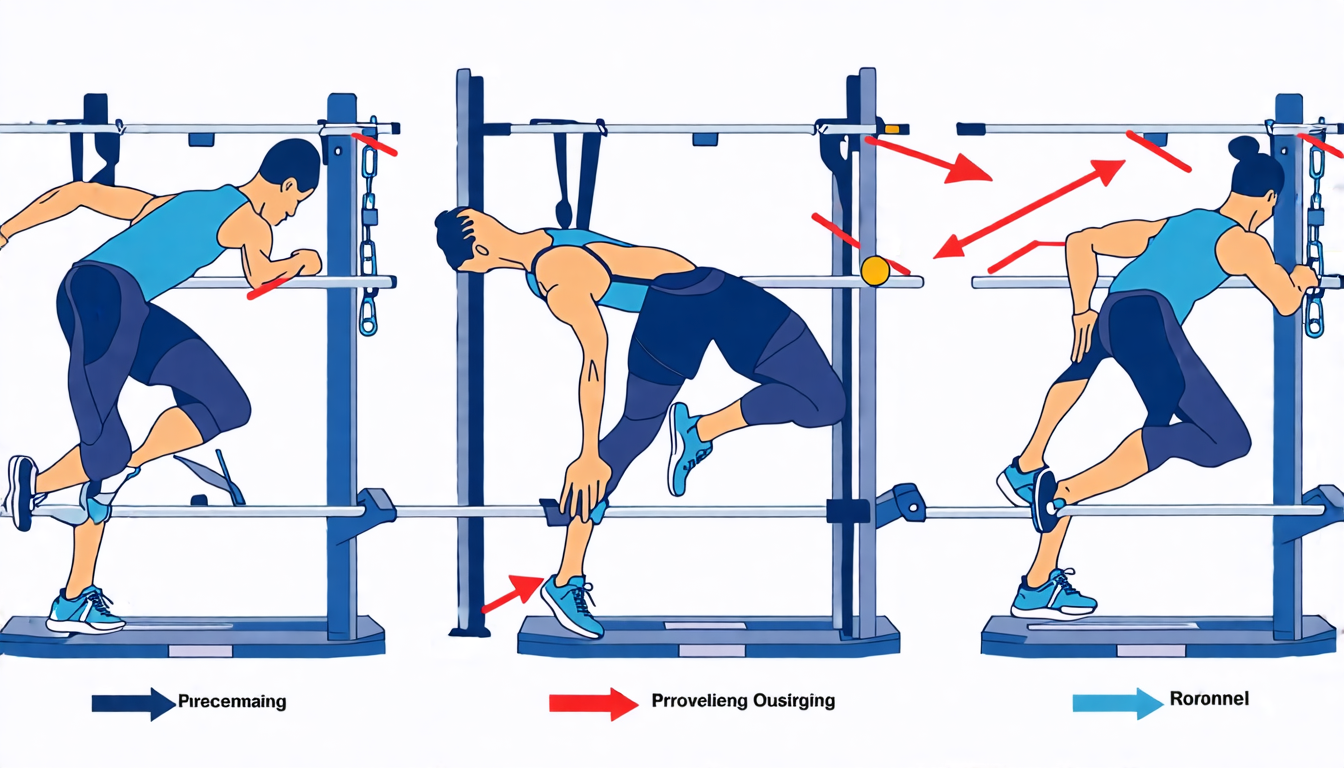Dips are a cornerstone in the realm of bodyweight exercises and an excellent addition to any fitness routine. Known for their versatility, dips can be performed in various forms, each offering unique benefits and targeting different muscle groups. Whether you’re aiming to build upper body strength, improve muscle coordination, or simply add a new challenge to your workout, dips can help you achieve your goals. Incorporating dips into your fitness regimen can enhance muscle definition, improve functional strength, and boost overall endurance. There are several types of dips to explore, including bench dips, parallel bar dips, and ring dips, each requiring different equipment and skill levels. As we delve into the world of dips, you’ll learn how to perform each type correctly, avoid common mistakes, and discover progressions to keep your workouts challenging and effective.
Introduction to Dips: Enhancing Your Fitness Routine
Overview of Dips as a Versatile Bodyweight Exercise
Dips are a powerful and versatile bodyweight exercise that primarily target the upper body, particularly the triceps, chest, and shoulders. Unlike many gym-based exercises that require specialized equipment, dips can be performed using simple apparatus such as parallel bars, a sturdy bench, or gymnastic rings. This versatility makes dips an incredibly accessible and efficient exercise for individuals at all fitness levels. Whether you’re a beginner or an advanced athlete, incorporating dips into your fitness routine can deliver significant gains in strength and muscle tone.
Benefits of Incorporating Dips into Workout Routines
Adding dips to your fitness regimen offers numerous advantages:
- Increased Upper Body Strength: Dips engage multiple muscle groups simultaneously, leading to enhanced strength in the triceps, chest, and shoulders.
- Improved Muscle Definition: As a compound movement, dips effectively promote muscle definition and growth in the upper body.
- Enhanced Core Stability: Performing dips requires a strong, stable core to maintain proper form, indirectly working the abdominal muscles.
- Functional Movement: Dips mimic movements we perform in daily life, making them highly functional for improving overall fitness.
- Versatility and Accessibility: The ability to perform dips using various equipment means you can adapt them to your workout environment, whether at the gym or at home.
- Minimal Equipment Required: Since dips utilize body weight, they require minimal to no equipment, making them an affordable and convenient exercise option.
Types of Dips
There are several variations of dips, each targeting different muscle groups and offering unique benefits. Here, we’ll explore three popular types: Bench Dips, Parallel Bar Dips, and Ring Dips.
Bench Dips
Bench dips are an excellent exercise for beginners. They primarily target the triceps but also engage the chest and shoulders. All you need is a sturdy bench or any elevated surface. By adjusting your feet placement and elevation, you can modify the difficulty of the exercise, making it suitable for various fitness levels. Bench dips are particularly useful for those looking to build foundational upper body strength before progressing to more challenging dip variations.
- Muscles Worked: Triceps, chest, shoulders
- Equipment Needed: Bench or elevated surface
- Difficulty Level: Beginner to intermediate
Parallel Bar Dips
Parallel bar dips are a step up from bench dips in terms of complexity and intensity. This variation targets the triceps, chest, and shoulders more dynamically by allowing a greater range of motion. You’ll typically find parallel bars at most gyms, but you can also invest in a dip station for home use. Parallel bar dips require significant core stability and upper body strength, making them ideal for intermediate to advanced fitness enthusiasts.
- Muscles Worked: Triceps, chest, shoulders, core
- Equipment Needed: Parallel bars or dip station
- Difficulty Level: Intermediate to advanced
Ring Dips
Ring dips are considered one of the most challenging dip variations due to the instability provided by the gymnastic rings. This instability forces your muscles to work harder to maintain balance and control throughout the movement. Ring dips not only target the triceps, chest, and shoulders but also engage smaller stabilizing muscles. This makes ring dips a comprehensive upper body workout and an advanced exercise that requires significant strength and coordination.
- Muscles Worked: Triceps, chest, shoulders, core, stabilizer muscles
- Equipment Needed: Gymnastic rings
- Difficulty Level: Advanced
Understanding the various types of dips allows you to choose the variation that best suits your fitness level and goals. Whether you’re just starting out or looking to push your upper body strength to new heights, there’s a dip variation that can help you achieve your objectives. By incorporating dips into your routine, you’ll not only enhance your strength and muscle definition but also add a dynamic and functional exercise to your fitness repertoire.

Step-by-Step Guide to Performing Dips Correctly
Detailed Instructions for Performing Various Types of Dips
Bench Dips
Bench dips are a great starting point for beginners. Here’s how to perform them:
- Find a stable bench or chair. Sit on the edge with your hands gripping the front edge, fingers pointing forward.
- Extend your legs out in front of you, keep your feet together, and slide your hips off the bench.
- Lower your body by bending your elbows until your upper arms are roughly parallel to the ground.
- Push yourself back up to the starting position by straightening your arms.
- Ensure your elbows do not flare out during the movement; they should be close to your torso.
Parallel Bar Dips
Parallel bar dips are more advanced and target the chest, shoulders, and triceps more effectively:
- Grip the parallel bars with your palms facing inward.
- Lift yourself up so your arms are fully extended and your body is suspended over the bars.
- Lean slightly forward and start lowering your body by bending your elbows.
- Descend until your upper arms are parallel to the bars or slightly lower.
- Push yourself back up by straightening your arms, returning to the starting position.
- Maintain a controlled motion throughout the exercise to avoid injury.
Ring Dips
Ring dips are the most challenging variation, adding instability to engage more muscle fibers:
- Set up a pair of gymnastic rings at a height where your feet won’t touch the ground when hanging.
- Grip the rings and lift yourself into the starting position with arms fully extended.
- Keep your elbows close to your body as you lower yourself down slowly.
- Descend until your upper arms are parallel to the ground or slightly below.
- Press back up to the starting position by extending your elbows.
- Focus on maintaining stability throughout the movement.
Common Mistakes to Avoid and Tips for Improving Form
Avoiding Common Mistakes
- Elbow Flare: Keep your elbows close to your body to prevent unnecessary stress on your shoulder joints.
- Shoulder Shrug: Avoid elevating your shoulders towards your ears. Keep them down and back.
- Partial Reps: Ensure you perform a full range of motion, going down until your upper arms are parallel to the ground.
- Lower Back Arching: Maintain a straight line from your head to your hips to avoid lower back strain.
- Speeding Through Reps: Perform each rep in a controlled manner, especially on the descent, to maximize muscle engagement.
Tips for Improving Form
- Warm-Up: Always warm up your upper body with dynamic stretches and light exercises before performing dips.
- Focus on Breath: Inhale as you lower yourself and exhale as you push back up.
- Engage Core: Tighten your core and glutes to maintain stability and proper alignment.
- Use a Spotter: If you’re new to dips, having a spotter can help ensure safety and proper form.
- Gradual Progression: Start with bench dips, then move to parallel bar dips, and finally ring dips as your strength improves.
Progressions and Variations to Increase Difficulty and Target Different Muscle Groups
Weighted Dips
To increase the difficulty of your dips, you can add weight using a dip belt or a weight vest:
- Secure a dip belt around your waist with a weight plate attached or wear a weight vest.
- Perform the dip exercise as you normally would, following the correct form.
- Increase weight gradually as you become stronger to continually challenge your muscles.
Assisted Dips
For those who find dips too challenging, using an assistance band can help:
- Secure an assistance band around the middle of the dip bars.
- Place your knees or feet into the band to support some of your body weight.
- Perform the dip as usual with the assistance, gradually using lighter bands as you gain strength.
Chest-Focused Dips
To emphasize the chest more, adjust your body angle and technique:
- Lean forward at a greater angle during parallel bar dips.
- Flare your elbows out slightly more, but avoid excessive flaring to prevent shoulder strain.
Triceps-Focused Dips
For more triceps activation, keep your body upright and elbows close to your sides:
- Maintain a vertical torso throughout the movement.
- Keep your elbows tucked in to increase the load on your triceps.
Plyometric Dips
For advanced athletes, plyometric dips add explosive movement to build power:
- Perform a standard dip but push yourself up explosively at the top of the movement.
- Lower yourself back down with control and repeat.
- Ensure you have a strong base level of strength before attempting plyometric variations.
Using these step-by-step guides, tips for proper form, and progression techniques, you can effectively incorporate dips into your workout routine to build upper body strength and enhance overall fitness.
Incorporating dips into your home fitness routine can significantly enhance your overall strength and muscle tone. This versatile bodyweight exercise targets critical areas such as the chest, triceps, and shoulders, offering substantial benefits regardless of your fitness level. By understanding and practicing the different types of dips—Bench Dips, Parallel Bar Dips, and Ring Dips—you can tailor your workouts to meet your specific needs and goals.
Our step-by-step guide provides clear instructions to ensure you perform each dip variation correctly, minimizing the risk of injury and maximizing effectiveness. By avoiding common mistakes and focusing on proper form, you can steadily progress and refine your technique.
Additionally, exploring progressions and variations allows you to continuously challenge your muscles and achieve new levels of fitness. Whether you’re a beginner looking to build foundational strength or an experienced athlete seeking to diversify your routine, dips are a valuable and adaptable exercise to include in your home workouts.
Embrace the power of dips to elevate your fitness journey. With dedication and practice, you’ll experience substantial improvements in strength, muscle definition, and overall physical health.

